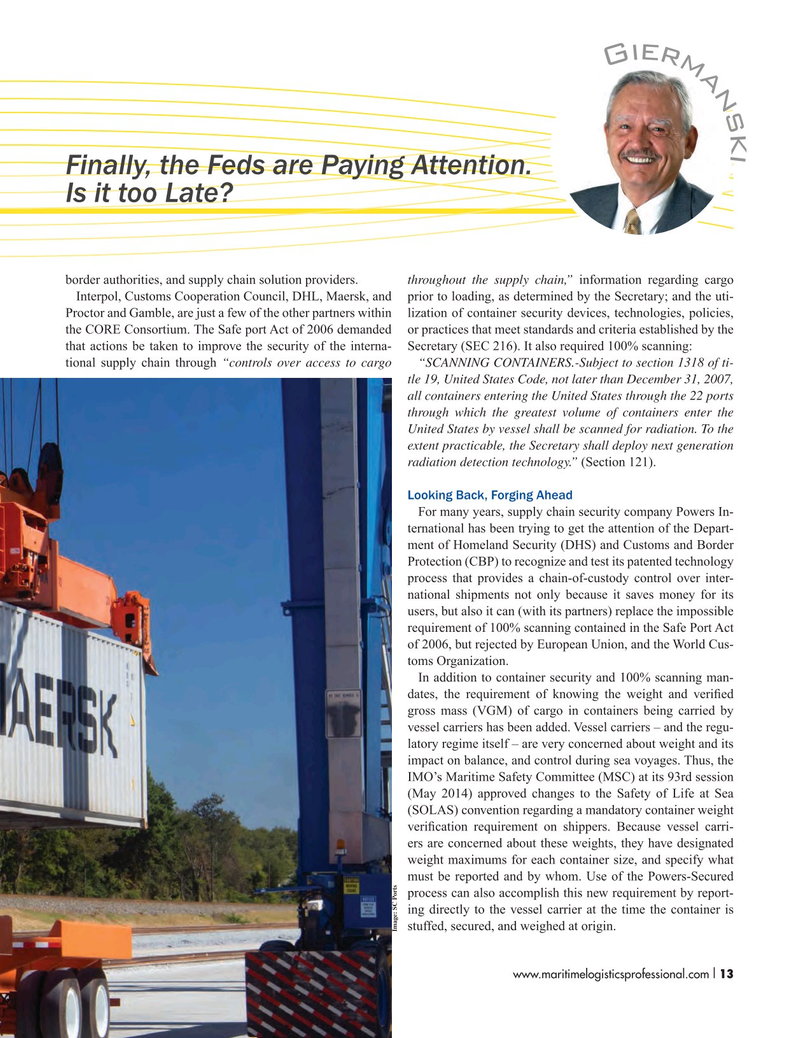
Page 13: of Maritime Logistics Professional Magazine (Q4 2016)
Workboats
Read this page in Pdf, Flash or Html5 edition of Q4 2016 Maritime Logistics Professional Magazine
e i r m
G a n s k i
Finally, the Feds are Paying Attention.
Is it too Late?
border authorities, and supply chain solution providers. throughout the supply chain,” information regarding cargo
Interpol, Customs Cooperation Council, DHL, Maersk, and prior to loading, as determined by the Secretary; and the uti-
Proctor and Gamble, are just a few of the other partners within lization of container security devices, technologies, policies, the CORE Consortium. The Safe port Act of 2006 demanded or practices that meet standards and criteria established by the that actions be taken to improve the security of the interna- Secretary (SEC 216). It also required 100% scanning: tional supply chain through “controls over access to cargo “SCANNING CONTAINERS.-Subject to section 1318 of ti- tle 19, United States Code, not later than December 31, 2007, all containers entering the United States through the 22 ports through which the greatest volume of containers enter the
United States by vessel shall be scanned for radiation. To the extent practicable, the Secretary shall deploy next generation radiation detection technology.” (Section 121).
Looking Back, Forging Ahead
For many years, supply chain security company Powers In- ternational has been trying to get the attention of the Depart- ment of Homeland Security (DHS) and Customs and Border
Protection (CBP) to recognize and test its patented technology process that provides a chain-of-custody control over inter- national shipments not only because it saves money for its users, but also it can (with its partners) replace the impossible requirement of 100% scanning contained in the Safe Port Act of 2006, but rejected by European Union, and the World Cus- toms Organization.
In addition to container security and 100% scanning man- dates, the requirement of knowing the weight and veri? ed gross mass (VGM) of cargo in containers being carried by vessel carriers has been added. Vessel carriers – and the regu- latory regime itself – are very concerned about weight and its impact on balance, and control during sea voyages. Thus, the
IMO’s Maritime Safety Committee (MSC) at its 93rd session (May 2014) approved changes to the Safety of Life at Sea (SOLAS) convention regarding a mandatory container weight veri? cation requirement on shippers. Because vessel carri- ers are concerned about these weights, they have designated weight maximums for each container size, and specify what must be reported and by whom. Use of the Powers-Secured process can also accomplish this new requirement by report- ing directly to the vessel carrier at the time the container is stuffed, secured, and weighed at origin.
Image: SC Ports www.maritimelogisticsprofessional.com 13I 1-17 Q4 MP2016.indd 13 11/10/2016 2:32:23 PM

 12
12

 14
14
